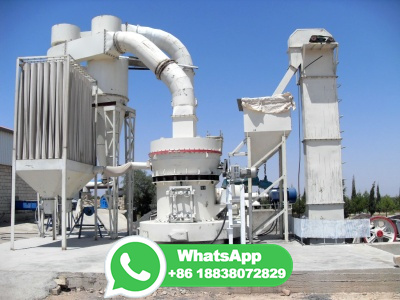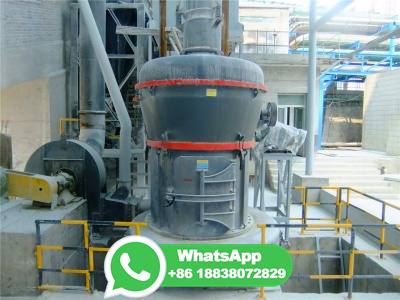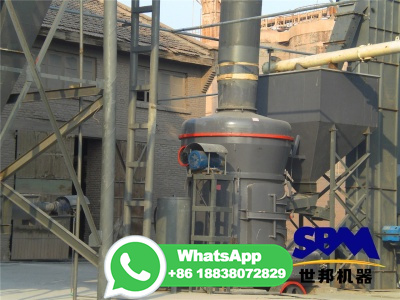![Explain the process of carbonisation and how coal is formed? [5 MARKS]](/zt4f2sg/407.jpg)
Solution Process : 3 Marks Carbonisation : 1 Mark Coal formation : 1 Mark About 300 million years ago the earth had dense forests in low lying wetland areas. Due to natural processes, like flooding, these forests got buried under the soil. As more soil got deposited over them, they were compressed.
WhatsApp: +86 18203695377
Cohydrothermal carbonization (coHTC) has emerged recently as a promising thermochemical technique that can transfer organic solid residue (, biomass, sewage sludge, plastic, livestock manure) into valueadded products (, hydrochar).This advanced mechanism conceals the weakness of hydrochars derived from the hydrothermal carbonization (HTC) of a single feedstock.
WhatsApp: +86 18203695377
If coal is to be carbonized to produce a char for power plant fuel, the value assigned to the char cannot be much greater than the value of the raw coal on a heat basis because a power plant can burn almost any grade of fuel efficiently.
WhatsApp: +86 18203695377
Production and Reference Material. Harry Marsh, Francisco RodríguezReinoso, in Activated Carbon, 2006. COALIFICATION. Description: Coalification is a geological process of formation of materials with increasing content of the element carbon from organic materials that occurs in a first, biological stage into peats, followed by a gradual transformation into coal by action of moderate ...
WhatsApp: +86 18203695377
DOI: / Corpus ID: ; An analysis of the carbonization process of coalbased activated carbon at different heating rates article{Ge2022AnAO, title={An analysis of the carbonization process of coalbased activated carbon at different heating rates}, author={Lichao Ge and Can Zhao and Tianhong Zhou and Simo Chen and Qian Li and Xuguang Wang and Dong Shen and ...
WhatsApp: +86 18203695377
Carbonization of coal is its decomposition by heat, out of contact with air, into a solid residue, coke, and liquid and gaseous distillation products. The main objective of the process of carbonization is the production of either hard coke or gas, the liquor being a valuable product in each case.
WhatsApp: +86 18203695377
Overview of General Steps of Primary Carbonization Process Primary carbonization has been extensively reviewed starting with Franklin [44,45] as the pioneer in these studies followed by the review works of Oberlin and Bonnamy [3639]. Primary carbonization refers to transformation of an initial precursor carbon to mesophase
WhatsApp: +86 18203695377
A correlation between the weight of hydrogen transferred and % carbon of each coal (coal rank) showed a similar tendency to that between Gieseler fluidity and coal rank. ... On the basis of the above results, chemical structural changes during carbonization process are discussed. 33 refs., 10 figs., 2 tabs.} doi = {/ef} ...
WhatsApp: +86 18203695377
Consequently, decarbonization will also require absorbing carbon from the atmosphere by capturing emissions and enhancing carbon storage in agricultural lands and forests. To achieve decarbonization, all aspects of the economy must change—from how energy is generated, and how we produce and deliver goods and services, to how lands are managed ...
WhatsApp: +86 18203695377
Description: Carbonization is a process by which solid residues with increasing content of the element carbon are formed from organic material usually by pyrolysis in an inert atmosphere. Notes:
WhatsApp: +86 18203695377
Here the product distribution and its release characteristics of the carbonization process of coalbased activated carbon at different heating rates were investigated. The results showed that the gas products mainly included H 2, CH 4, CO, CO 2, C n H m and H 2 S. The results of GCMS analysis showed that the contents of phenols and dehydrated ...
WhatsApp: +86 18203695377
Carbonization is a lowtemperature thermochemical process that converts organic matter in the absence of oxygen mainly into char, gas, and liquids. Biocoke is a char prepared from a mixture of biomass/charcoal and a coal blend. It can reduce greenhouse gas emissions by replacing coke and reducing coal consumption in the ironmaking process.
WhatsApp: +86 18203695377
The behavior of coal chlorine in metallurgical cokemaking process was investigated. Various coals were carbonized (heattreated) in a nitrogen atmosphere and the ratio of the chlorine in the heattreated sample to that in the coal was defined as the chlorine residue ratio. The release of chlorine from coal during carbonization is a slow process ...
WhatsApp: +86 18203695377
Coal is a black or brownishblack sedimentary rock that can be burned for fuel and used to generate is composed mostly of carbon and hydrocarbons, which contain energy that can be released through combustion (burning). Coal is the largest source of energy for generating electricity in the world, and the most abundant fossil fuel in the United States.
WhatsApp: +86 18203695377
Products In the Karrick process, 1 short ton of coal yields up to 1 barrel of oils and coal tars (12% by weight), and produces 3,000 cubic feet (85 m 3) of rich coal gas and 1,500 pounds (680 kg) of solid smokeless char or semicoke (for one metric ton, m³ of oils and coal tars, 95 m³ of gas, and 750 kg of semicoke).
WhatsApp: +86 18203695377
Article Vocabulary Coal is a black or brownishblack sedimentary rock that can be burned for fuel and used to generate electricity. It is composed mostly of carbon and hydrocarbons, which contain energy that can be released through combustion (burning).
WhatsApp: +86 18203695377
[2] Carbonization is a pyrolytic reaction, therefore, is considered a complex process in which many reactions take place concurrently such as dehydrogenation, condensation, hydrogen transfer and isomerization . Carbonization differs from coalification in that it occurs much faster, due to its reaction rate being faster by many orders of magnitude.
WhatsApp: +86 18203695377
Hydrothermal carbonization ( HTC) (also referred to as "aqueous carbonization at elevated temperature and pressure") is a chemical process for the conversion of organic compounds to structured carbons. It can be used to make a wide variety of nanostructured carbons, simple production of brown coal substitute, synthesis gas, liquid petroleum ...
WhatsApp: +86 18203695377
This study focuses on the hydrothermal carbonization (HTC) to enhance the physicochemical properties of coal tailing (CT), coal slurry (CS), and a blend of the two coal and SS in order to produce ...
WhatsApp: +86 18203695377
The carbonization process of the coal begins at the top and at the bottom of the fixed mass. Then the carbonization front moves continuously through the coal mass. The heat required for thermal decomposition and carbonization is generated by combustion of volatile matter released from the coal mass. The volatile matter is partially combusted in ...
WhatsApp: +86 18203695377
Silicon carbide nanoparticles (nSiC) have been used to modify coal tar pitch (CTP) as a carbon binder. The influence of ceramic nanoparticles on the structure and microstructure was studied. The structure of CTPbased carbon residue with various nSiC contents was analyzed by using SEM with EDAX, Raman spectroscopy, and Xray diffraction. The effect of ceramic nanofiller on the crystallite ...
WhatsApp: +86 18203695377
Carbonization of coal Carbonization : is a process in which coal is heated in the absence of oxygen. After combustion, carbonization of coal is the most important use of coal to produce coke. Coke : is the solid residue that remains when coal is heated out of contact with air. Principal use : Coke is basically formed, so that it can be used in iron and steel
WhatsApp: +86 18203695377
This is considered because chlorine in coal is dispersed in coal molecular structure and the release of chlorine from coal during carbonization is a slow process (Nomura, 2010), while PVC which is added as a 25 mm waste plastic agglomerate decomposes and the releases of chlorine as HCl from PVC are faster than coal. The chlorine residue ratio ...
WhatsApp: +86 18203695377
Carbonization The process of strong heating of coal in the absence of air converting it into coke is known as carbonization of coal. Coke Lustrous, dense, porous and coherent mass obtained by strong heating of coal in the absence of air is called coke. Types of carbonization a) Lowtemperature carbonization heating coal at 500 7000C.
WhatsApp: +86 18203695377
The maximum mass loss for coals occurs in the temperature range 400500 °C. Table 6. Mass loss (wt%) for coals and biocoals during carbonization. During the thermal decomposition of biocoals and coals the gases H 2, CO, CO 2, H 2 O, and ionized hydrocarbons such as CH+4, C2H+5 were detected.
WhatsApp: +86 18203695377
hi, i talk about carobonization of coal, process of carbonization, types of carbonization and difference between low temperature carbonization and high temp...
WhatsApp: +86 18203695377
process is called cohydrothermal carbonization or coHTC. CoHTC process can upgrade the fuel properties of coal as well as coal waste and can reduce the concentration of toxic elements (, sulfur, chloride) [4, 11]. CoHTC process can convert the heterogenous feedstocks into a homogenous mix
WhatsApp: +86 18203695377
The properties of the carbon materials obtained as the final product of coal tar pitch carbonization process are a consequence of the type of chemical and physical phenomena occurring through the process.
WhatsApp: +86 18203695377